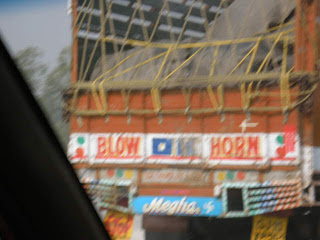
Last Friday while on a road trip up north towards Gujarat, I amused myself in the 6 hour long drive taking pictures of 'Horn OK Pleases' on trucks' butts on the express way.
One delightful characteristic of Indian trucks is its colourful paintings and adornments, paintings of Indian animal icons and other motifs - elephants, tortoise, kingfishers, lotus flowers, tristan, the 'Swastika' (not sure what they're called in India. Should find out), Indian national flag, patriotic slogans, and of course the ever delightful variations of 'Horn ok please' at the back.
One delightful characteristic of Indian trucks is its colourful paintings and adornments, paintings of Indian animal icons and other motifs - elephants, tortoise, kingfishers, lotus flowers, tristan, the 'Swastika' (not sure what they're called in India. Should find out), Indian national flag, patriotic slogans, and of course the ever delightful variations of 'Horn ok please' at the back.



Pretty trucks and generic cars apart, our car went past lofty mountains, sprawling townships, ducked through well-lit tunnels below the mountains, past bullock carts with high piling hay, past rubber trees, past black and brown cows grazing on the hills, past bald mountains, past abandoned constructions, past Shah Rukh Khan's bungalow on the hill top. A number of tolls, couple of checkpoints, road tax, a fine for not wearing seatbelt and a very righteous officer refusing a bribe ("We Gujaratis don't accept dirty Maharashtrian money!") later, we arrived in Silvassa, an independent union state inbetween Gujarat and Maharastra. My favourite cousins - the cows are in abundance in this town. They laze around in the middle of the busy roads, accustomed to crazy blares of horns and swirling dusts and gravels. What would India be without cows. 









The countryside is not too different from the ones in Malaysia, except instead of wooden houses with zinc roofs on stilts, there are mud walls (don't know) and hay rooftops. And I can't get enough of seeing oxens ploughing the land. Antiquated, but nonetheless a rare sight nowadays, back when every drop of rice was cherished for the blood and sweat of the farmer and the toil of the ox under the master's whip, now less valued as emotionless machines take over to churn out massive amounts to our plates.

Small roads, leafy green trees, men and women carrying loads on their heads, walking skillfully alongside our car. We arrived in Daman beach just as darkness prevailed. Having a full round moon above our heads and night setting in, the tide is so low it is not visible even in the horizon. Yes, according to Mr. Suthar, this part of the beach has the highest tide difference in the world.

It is on this beach that I had a camel ride. Camel was there, sitting obediently with a string attached to it, held on the other end by its master. Seeing that night is here, there were few people on the beach. Having a no-supporting-trade-using-animals policy, I was content just getting close to Camel, display my utter compassion for all living beings and hoping it will in turn, be overwhelmed with so much love that it will mouth the words 'thank you', get up and whisk me away in its humps to a secret oasis in the desert. With a bit of apprehension, I extended my hand to touch its neck. When it didn't open its mouth and chew on my hand like a carrot, I went closer, landed on the tiny rough furry skin and it wiggled. Annoyed? Pleasurable? Mr. Suthar and my Chinese clients were encouraging me to go on a ride but I refused.

But then, I got on anyway.
Camel was there for a purpose, and the purpose was to be ridden and paid money to the owners. Had I boycotted it, it will not serve its sole purpose and would remain idle there on the beach. Possibly kneeling down with a string in the tight grasp of its owner for a few hours, it could get a bit of stretch on its legs. And perhaps some extra money on the owner's pocket would make him treat Camel better? This was what I thought.
It stretched its long hind legs, then got up on its front legs. It stood and I was high above the ground. My spectators were anxious about me secure on the seat as you'd have probably heard of the camel's notoriety for its jerky movements getting up. It walked 50 meters forward along the coast, then 50 meters back to the same spot where we started. So much for a good walk for Camel. It was held on a rope tightly and pulled to whichever direction the master wants it to go. In the end, I wasn't feeling that good about this charity to Camel's owner. Perhaps not giving support is still the best option.
Anyway, back to Horn OK Please. It is a driving courtesy, a safety measure, a motif of truck painting, a fun camera-clicking exercise, an example of Indian English, a phrase to say with heads shaking sideways in typical Indian fashion, a name of a restaurant, a title of a film, and also a Wikipedia entry:



So, horn Ok please. Lets create a symphony of honking trucks in the express way. :)







No comments:
Post a Comment